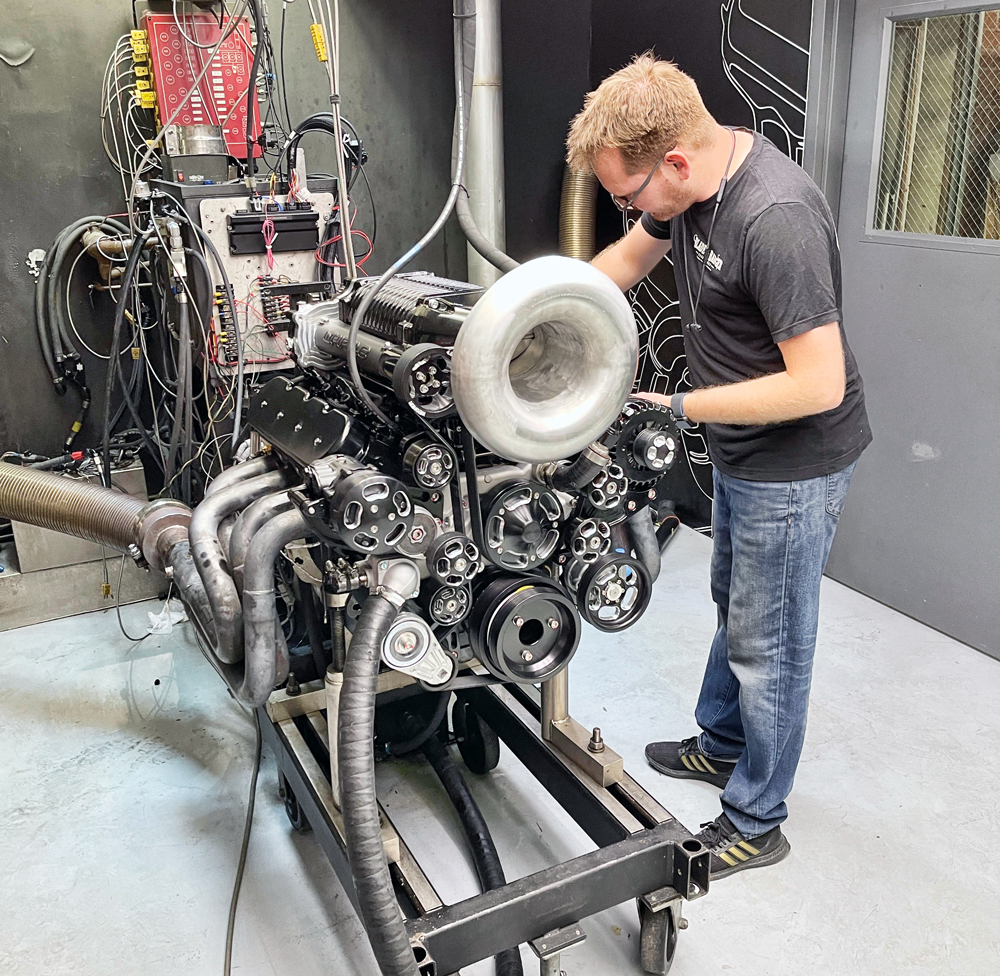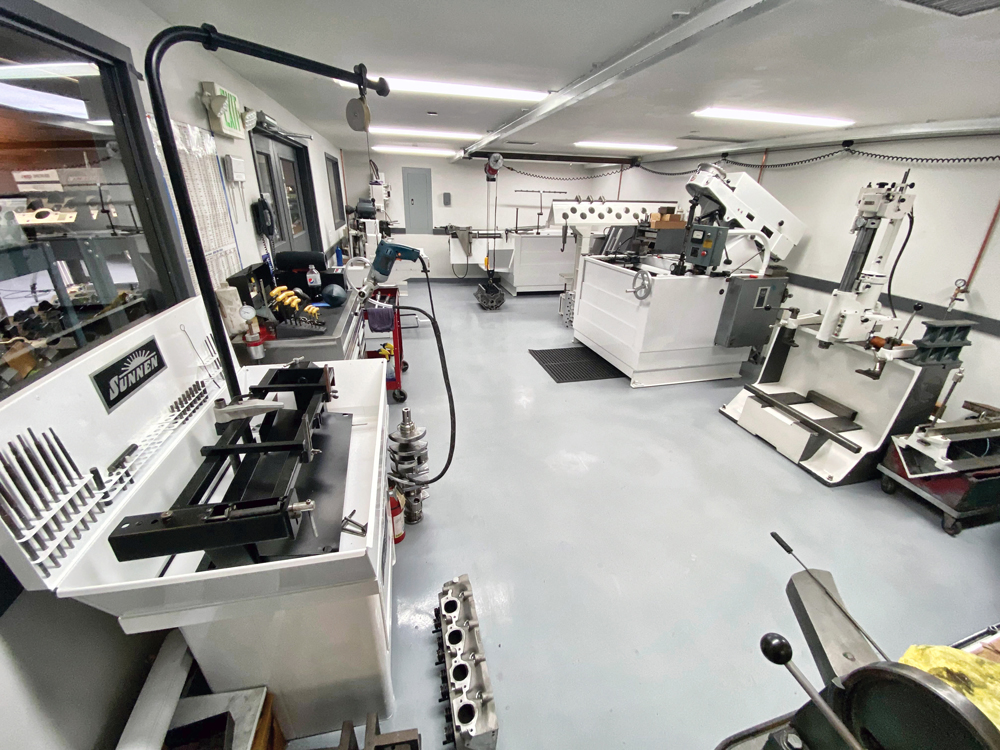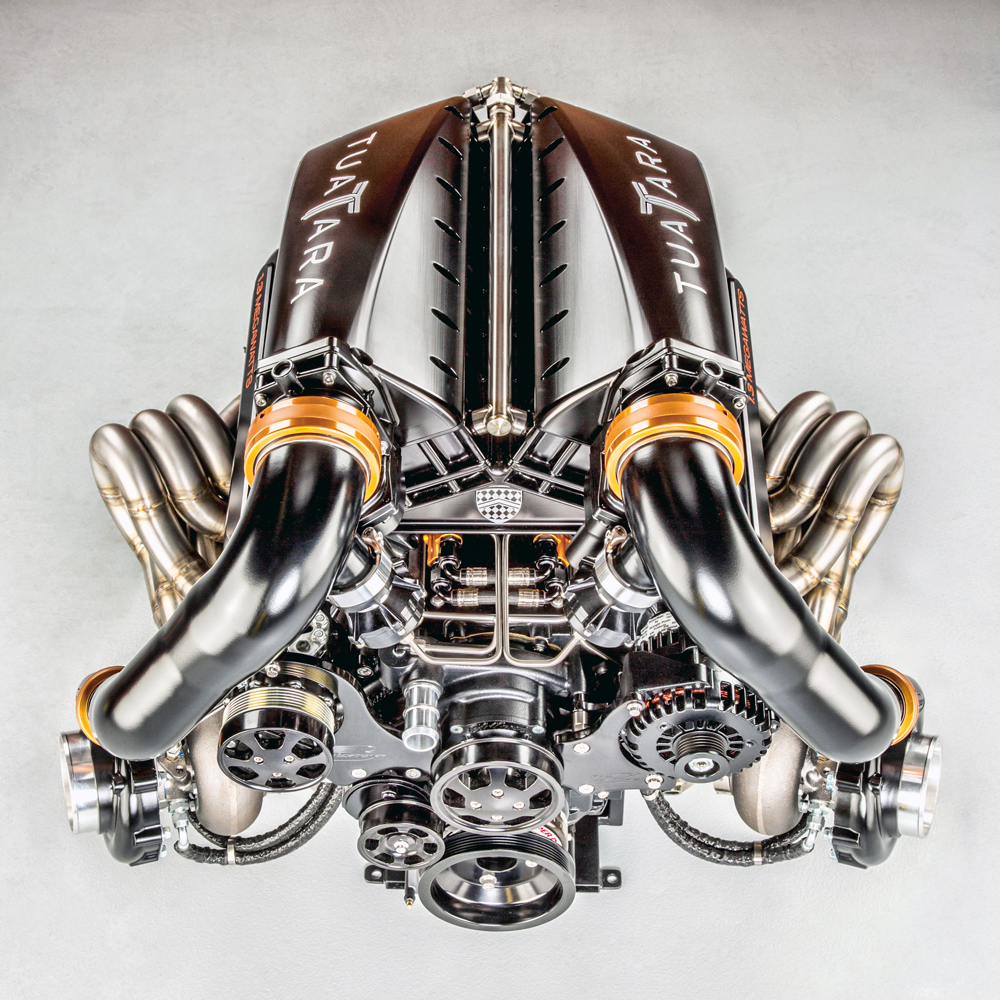Business Profile: Nelson Racing Engines

In a constantly changing landscape, this southern california shop continues to innovate, adapt, and thrive.
It’s the mid-1980s in Southern California’s San Fernando Valley. A 12-year-old boy straps into the passenger seat of his dad’s De Tomaso Pantera, ready for an exhilarating drive as usual. But this ride would prove to be particularly thrilling. The boy’s father had just bolted a pair of turbochargers to the Ford V8 perched right behind their seats. After a couple of full-boost runs in the now-even-faster mid-engine coupe, the boy was hooked for life. That boy was Tom Nelson, founder of Nelson Racing Engines (NRE).
Since 1995, NRE in Chatsworth, California, has put together engines that are both immensely powerful and wondrous to behold. Anyone who has attended a major car show or flipped through the pages of a performance magazine in the last 25 years is most likely familiar with its work. The shop has produced some jaw-dropping custom builds over the years, and from the very beginning, Nelson has strived to balance function and form.
“We came up with these near mirror-image turbos back in the day,” he said. “Other people have them out now because we sold the patent to Precision Turbo & Engine, but we manufacture our own. We sell a whole bunch of those.
“Up until we made that, there wasn’t a counter-rotating turbo. In a V8 there wasn’t a clockwise and a counterclockwise turbo. They were only clockwise. So they always kind of looked funny. We made a counterclockwise one, for a left and a right turbocharger, and that way the headers can look the same, the intercooler pipes can look the same, and it really adds to the whole look of the engine.”
In addition to being highly aesthetically pleasing, a symmetrical twin-turbo setup has some unexpected performance benefits.
“Thinking in terms of reliability,” Nelson said, “having the left side the same as the right side adds reliability. If the left side has different conduit lengths that are going to affect the way it’s tuned comparative to the right side, then it’s going to change the way it’s tuned.”

To this day, NRE’s twin-turbo kits are still its bestseller. But coming in a close second are its crate motors, which Nelson said are also built with both function and form in mind. “I think we have a specific aesthetic,” he explained. “Like our engines, usually when we build it, you know that we built it. It’s done a specific way. I like to think that we’re not just making horsepower, we’re making functional art.”
Nelson expanded on why big power isn’t enough for him: “Years ago, we kind of capped out where we need to be power-wise for a street car. It wasn’t really about finding every ounce of horsepower when we already had more than we’d ever need for a street car. I like the idea of the engine being a piece of art, like the engine bay is a picture frame and the motor is the jewelry. We try to hide a lot of stuff, where it looks like it doesn’t even run. We hide throttle linkage, we have injectors put on the inside of the intake, wiring that’s out of sight. So then it becomes beautiful.”
Keeping Pace With Technology
As Nelson alluded to, turnkey crate engines more or less hit their performance ceiling years ago. With that said, it would be easy to become complacent and keep offering the same crate motors year after year. That’s just not how NRE does things.
“We’re always changing,” he said. “In this industry everything’s moving fast. Everything. There’s 3D scanning, 3D printing, all the advancements in fuel management, lightweight components and a lot more innovations each year. So we spend a lot of time in research and development trying ‘what if’ ideas. I think that keeps us fresh. If you’re doing the same thing over and over, you’re going to get left behind.”
Nelson pointed to his shop’s crate motors as a prime example. “Those crate motors are probably getting improved quarterly. If we find we like a certain valve better, we’re changing all those valves. If we find that we like a certain cam that’s making a little bit more power, we change it. In this shop we’re never staying stagnant, we’re always trying to one-up what we did before.
“It’s really about the process,” he continued. “We just keep refining our process. We can always do better. At the shop we’re always wondering, what used to be really good yesterday is probably not going to be really good three to six months from now because we keep refining it.”
When asked what has changed the most since he started in the business, without missing a beat, Nelson said, “The electronics.”
He explained, “When I started, 500 hp was big. Now 1,000 hp is normal, and probably the biggest change that’s made that possible are the electronics that manage it all.”
Just as the parts have evolved, so have the tools. “We’ve got a DTS engine dynamometer that we do a lot of engine testing on, and then we have a cylinder head flow bench. We also do a lot of remote tuning, so we end up getting a lot of feedback from data logs.”
Another Satisfied Customer
Tim Cagle at TCD Motorsports, an NRE customer who purchased a 1,500-hp LS 427 twin-turbo crate motor and transmission for his 1986 Chevy square body pickup truck project, can attest to the level of tuning and service that comes with an NRE engine.
“Everything’s just so over the top,” Cagle said. “Tom does the dyno. He provides the service after we get it started up and installed in the truck. There’s a port where an iPhone plugs in, and he will tune it from the shop on his laptop, whether you’re in another state or just driving it down the street.”
Cagle said NRE was “the obvious choice” to provide a motor for his C10. When pressed on why he went with NRE, he said, “The build was getting excessive, and I didn’t want to shortchange it in the motor department by putting just an LS or LS3 or crate motor of any sort. I had to get the engine to match the build.”
The tremendous effort Nelson puts into his engines to make them stand out did not go unnoticed for Cagle.
“To me, an NRE engine is just a machined piece of art,” Cagle said. “The fabrication, the machining, it just looks like art. It’s not something you see everywhere. I only see that level of detail in high-end magazine builds. Everything about them was so over the top: the service, the tech end of things. And Tom was always right there. If I needed anything mocked up or modified or changed, he was willing to handle it. It was full hands-on service. Plus, there are not many people who offer a 1,500-hp crate motor with a warranty. When it’s picked up, they’re not setting it on a tire in the back of the truck. It comes with a powder-coated engine stand that’s bolted to the motor. Just an over-the-top outfit.”
Taking Care of Business
Though NRE has grown substantially since its humble beginnings, Nelson still considers his company a homegrown operation. “We’re still a small shop,” he said. “We have a 16,000-square-foot garage and a little more than a dozen employees.”
His tech staff is made up of six engine builders, two fabricators, a machinist, a sheet-metal guy and a wiring guy. Though the majority of his employees work hands-on with engines and cars, like any company, NRE has folks (salespeople and bookkeepers) who help the business run behind the scene.

When asked how he recruits his employees, Nelson said he’s had existing work relationships with many of them.
“The guys who are working here I’ve kind of sought after,” he said. “We’ve got some really good tube conduit guys who do headers, intakes, intercoolers, etc., and these are guys who I’ve worked with for many, many years. Over the years we’ve developed a relationship, and I finally got them to work with me. Same with the engine builders. Currently, we have previous IndyCar-winning engine builders. Another guy ran an engine shop for 10 years. So the guys who are in this shop are really the best in the country.”
When it comes to training, there are a few skills specific to what NRE does that will be learned on the job, but generally speaking, applicants should already be masters of their craft.
“There are certain positions that need training. Right now we’re looking for a block prepper, which we would train for,” Nelson explained. “But the guys who are doing the heavy lifting are guys who have done it for 30 years. There are some young guys in here, too, who are like 29 or 30, but they’ve been doing it since they were kids so they’re all really talented guys. That’s the one nice thing that I can definitely say about my engine shop—I have a lot of trust in what they do.”

One position NRE doesn’t have is a social media specialist, because Nelson runs all of the shop’s social media accounts himself. Currently, Nelson Racing Engines has 262,000 followers on Instagram, 162,000 followers on Facebook, and 143,000 subscribers on YouTube. “For an engine shop we’ve got a pretty good-sized social media presence,” he said modestly.
Social media is how NRE engages with its customers outside of the shop. “We don’t do a lot of shows, so that is the best way for us to interact with our audience.”
It’s through those same social media channels, Nelson said, that NRE gets most of its new customers.
Getting Through the Pandemic and Beyond
Like every other business, NRE was thrown a major curveball in 2020 when the COVID-19 pandemic hit.
“Originally, one of my guys had a stroke from COVID,” Nelson said, speaking of the early days of the pandemic. “We really didn’t know much at that point. It was scary. So we really didn’t work for a month or two. Then we came back and started working.”
But instead of coming back to a slow trickle of orders, they had a long waiting list of people wanting to buy engines and parts.
“People were going stir-crazy, so everybody went into their garage,” he said. “They’re not spending money, they’re not vacationing, they’re just stuck in their garage, and they want to build stuff. If I had the parts, I could’ve sold like a zillion engines, but COVID made parts almost impossible to get.”
The supply shortages and increased demand have forced NRE to limit the number of orders it can accept, but it’s still busier than ever. “For us, we had to be careful how much business we would take in because we had to be able to get it done and we had to be able to get the parts,” he said. “We’ve pretty much extended our timelines—it’s almost double now—because of COVID. I mean, I’ve had blocks on order for over a year. Certain things we just can’t get. We can’t get a computer—five months I’ve been waiting for a computer. Engine bearings we can’t get. Intake gaskets we can’t get.”
Despite parts being in short supply, NRE is producing about four engines a week, and its bread-and-butter twin-turbo kits continue to be hot sellers.

Nelson plans to offer more affordable crate motor packages while continuing to perfect NRE’s craftsmanship. “We’re really kind of known for these really expensive engines,” Nelson admitted. “So we’ve been figuring out through buying power and making deals with a lot of the big brands to be able to buy at a lower rate and pass those savings to the customer. We’re going to have a bunch more affordable crate packages that are essentially custom badass motors but at a crate-engine price.”
Affordable is a relative term, and Nelson clarified by saying these packages will be a bargain for what they are. “We have a supercharged engine that we sell for like $26,000,” he said. “It used to sell for $36,000. We were able to figure out how to make it for $10,000 less. We have a twin-turbo 427 LS that we sell for $29,000 that used to be $42,000. We’ve come up with ways to make the package actually nicer than it was but also more affordable.”
When asked if some of those savings could come from outsourcing production, Nelson was adamant that everything will still be built in-house. “Everything has to be built here,” he said. “If we’re going to have our name on it, we’re going to build it.”
 MEMBERSHIP LOGIN
MEMBERSHIP LOGIN JOIN PRI
JOIN PRI


